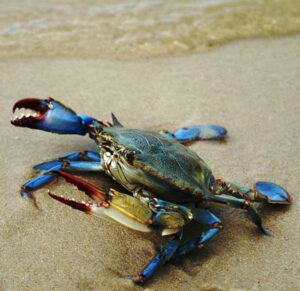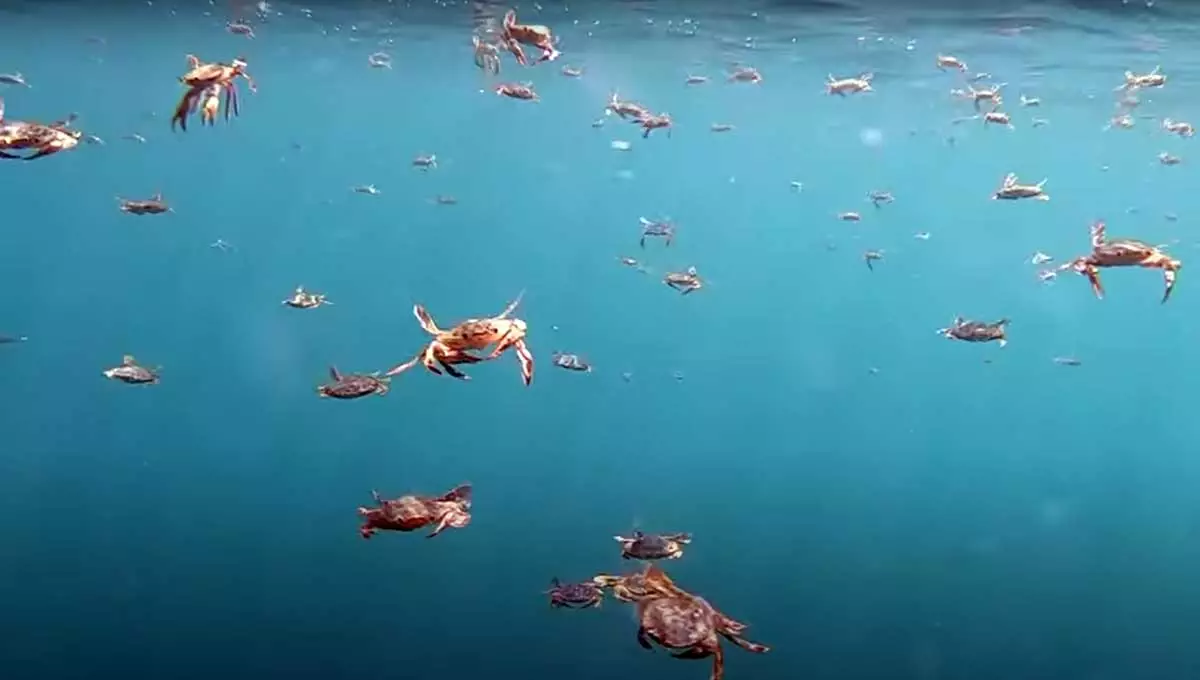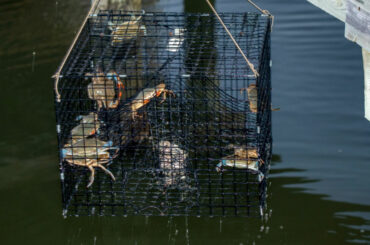Table of Contents
This article is devoted to seeking answers to all of the questions that you may have about the interesting question “Can crabs swim in water?”
Crabs are crustaceans, which means they are invertebrates. Crabs come in nearly five thousand different species, with the majority living along the shore in salty, fresh, or a mix of fresh and salty water. Some crabs are semi-terrestrial or terrestrial, in addition to aquatic species (they live on the land). They prefer sandy places with stones and boulders to live in.
Crabs can swim. However, they are not particularly good swimmers. Crabs use their legs to paddle through the water, but their bulky shells make it challenging to move quickly. As a result, crabs typically only swim when they need to escape from predators or find new food sources. When crabs do swim, they often travel in groups. This gives them a better chance of safety in numbers and helps them find food more efficiently.
But not all crabs can swim. There are some species gifted with this ability. Also, they swim in different styles and for different purposes. Curious, what are they? Keep reading.
Read More: Do Crabs Grow Their Legs Back?
Can crabs swim like a fish?
In fact, not all crabs are capable of swimming like fish. Crabs are considered amphibious animals because of their ability to swim and walk on land. There are only a few kinds of crab that are capable of swimming.
Walking and running are the primary modes of locomotion utilized by most of them while traversing the seafloor. Some species, such as the blue crab that lives along the Atlantic coast, are capable of swimming. They propel themselves through the water with paddle-like modifications to their enhanced hind legs.
Why do crabs swim?

Crabs can swim long distances by moving their legs in a rowing motion. Although they are not the fastest swimmers, they can cover a lot of ground using this locomotion method. There are several reasons why crabs might swim.
For example, they may be trying to move to other areas searching for food or mates. Or, they may be trying to escape from predators. In addition, crabs may swim to find areas with better oxygen levels. Whatever the reason, swimming is an essential ability for crabs.
Can crabs breathe in air and water?
Crabs breathe through gills like fish. However, crabs can breathe outside of water. Because crabs’ gills don’t collapse and cling together outside of water, their ability to absorb oxygen remains intact until they dry out. Crab gills don’t collapse or stick together outside water. These reinforcements prevent collapse like tent reinforcements. Crabs can retain water in their gill chambers to breathe while dry. They have long-term adaptations, including oxygen-absorbing gill linings. Each crab fits its habitat wonderfully.
Crabs have two-gill chambers to breathe underwater. Water enters their gill chambers through leg apertures and departs through mouth openings. Crabs’ respiratory appendages act like paddles transporting water through their gill chambers. Their gills absorb water and oxygen.
The blue crab can only survive 24 to 48 hours outside water because its gills are not as stiff as land-adapted crabs. To recirculate their gill chamber’s oxygen supply, they can either recirculate water over their gills or bubble air through it. This technique is frequently used for short lengths of time outside the water.
To survive outside the water for a long time, crabs need to be able to breathe. Land-adapted crabs such as the coconut crab and the black-backed land crab do not require water in their gill chamber to breathe. Additionally, the lining of the gill chambers of these crabs may absorb oxygen.
Read More: How Many Legs Does a Crab Have?
Which species of crabs cannot swim?
Some crab species can swim. Some crabs cannot. Although crabs live in water, most of them cannot swim or swim through bodies of water. As previously noted, crabs in the family Portunidae can swim with their modified back legs, known as swimmerets.
These modified rear legs are paddle-shaped and can rotate up to 40 times per minute, enabling crabs to swim across bodies of water. Some crab species, such as the spider crab and the stone crab, may run or walk across the ocean floor. Only swimmerets are capable of swimming to the surface. Their paddle-like legs enable them to swim through bodies of water.
Crabs swim for various reasons, and experts believe that swimming assists them in relocating to a new place or finding food. Additionally, swimming helps them avoid predators. Crabs swim when they cannot climb over or around obstacles, as swimming helps them overcome obstacles. When oxygen levels in the water are too low for survival, they can swim to the surface of the ocean or land.
Read More: Most Popular & Expensive 7 Edible Types Of Crab In The World
Is it possible for crabs to swim upside down?
The horseshoe crab is a kind of crab that swims upside down. They swim at an angle of nearly 30 degrees with the ocean floor. This is not typically observed. There is a reason they swim upside down, as it has several advantages. The swimming behavior of horseshoe crabs is believed to be hereditary.
They learn this when embryos inside their transparent eggs lie on their backs. Researchers have found that grown eggs use their book gills and legs to achieve sufficient movement within the egg. Additionally, recently hatched larvae can be spotted swimming to the surface.
Do crabs swim in their larval stage?
Crab larvae hatch from eggs and spend most of their early lives in the water before transitioning to land. In their larval stage, most crab larvae swim vertically in the water. They are relatively poor swimmers, but they can use their gills for breathing and their long tails to propel themselves through the water.
The larvae go through several molts as they grow, shedding their exoskeletons and growing new ones. Eventually, they will develop into juvenile crabs and make their way to land, where they will live for the rest of their lives.
Can Crabs Swim Backwards?
It may come as a surprise to learn that crabs can swim backward. This movement is primarily used to escape, as it allows crabs to quickly move away from predators. However, it also comes in handy for crabs on unfamiliar terrain. By swimming backward, crabs can orient themselves and make their way back to familiar territory. In addition, this form of locomotion also allows crabs to travel upstream against strong currents.
Can blue crabs swim?
Blue crabs are a type of crab that belongs to the Portunidae family. These crabs can swim. The blue crab is known as a decapod because of its ten appendages. Four pairs have segmented legs, while the fifth has paddle-like legs that allow them to swim.

These legs, also known as paddle fins, are highly flexible. They can be spun in a sculling motion to move the crab through the water. Blue crabs have a unique body structure that allows them to swim more freely than other crab species. They can be spun in a sculling motion to move the crab through the water. They can travel at rates of up to one meter per second.
Finally, we learned that some species of crabs can swim in water with the support of their specific body structures. And some species can’t swim. And some species of crabs can breathe outside the water as well. They have a particular system in their body to breathe air. That is the diversity of our planet. Differences make the earth a wonderful place.
Read More: BEST Useful Best Blue Crab Traps
FAQ
Can hermit Crabs swim and breathe underwater?
Hermit crabs inhabit the ocean floor. They use rocks and crevices to ascend to the surface or wait for the tide to recede. Hermit crabs found on land immerse in water, but they do not swim for enjoyment. Hermit crabs on land can only breathe underwater for a limited time. Hence they are susceptible to drowning. Hermit crabs on land will not swim to the surface for oxygen. While all hermit crabs, whether aquatic or terrestrial, require water, it is uncommon for hermit crabs to swim.
Can Crabs Swim To The Surface?
It turns out that crabs are surprisingly good swimmers and are capable of reaching the surface from great depths. However, they usually only swim upwards when looking for food or mates. When they are not actively searching for something, crabs tend to stay close to the bottom of the ocean, where they feel more secure.
Can Hermit Crabs Swim?
Surprisingly, hermit crabs are capable of swimming. They use their legs to paddle through the water and their large claws to grab onto rocks and other objects. Although they are not strong swimmers, hermit crabs can travel long distances by riding currents.
Can King Crabs Swim?
King crabs get their name from their large size, and they are found in colder waters near the Arctic and Antarctic. While most other crab species can swim using paddle-like appendages, king crabs cannot. Instead, they walk along the ocean floor using their legs. This is likely because king crabs have evolved to have heavier bodies than other crabs. The added weight makes it difficult to float, so they rely on their legs for locomotion.







